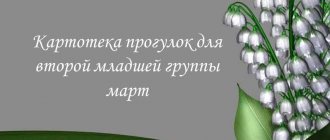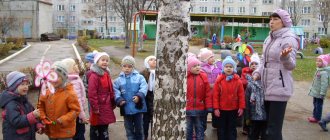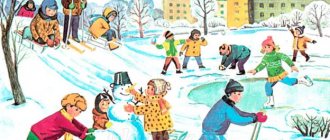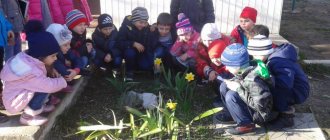Card index. “Observations in the spring on a walk in the middle group.”
Transcript
1 Card file “Observations during a walk in the middle group in the spring.” Author of the work: Nazarenko Lyudmila Nikolaevna Educator of MADOU 5 “Golden Key”, Leningradskaya village, Krasnodar region Observation: wind. Reading an excerpt from the poem “The Tale of the Dead Princess...” by A.S. Pushkin “Wind, wind, you are mighty...” Invite children to determine the properties of the wind in one of the ways known to them (look at the swaying branches, use turntables, analyze their own sensations from the influence of the wind), characterize them. Tell the children how a person uses the power of the wind for his own purposes. Observation “Length of daylight”. Draw children's attention to the significant increase in daylight hours compared to December, and note the height of the sun at noon above the horizon. Vocabulary work: sun, high, shining, day, long, longer night, shorter. Observation "The first signs of spring." Introducing children to the characteristic signs of spring, teaches them to identify changes associated with the sun (it shines brighter, warms more, daylight hours lengthen). Bird watching. Draw children's attention to changes in the behavior of birds, offer to feed them crumbs, talk about the appearance and behavior of birds. Didactic game “When does this happen?” Clarify and deepen children’s knowledge about the seasons, teach them to give a detailed answer, and give reasons for their opinions. Conversation “Building birdhouses.” Tell the children how birdhouses are built and placed, discuss why they are built. Invite the children to make birdhouses together with adults. Work in a corner of nature. Observation "Growth of onion leaves." Invite the children to tell how the experiment was carried out, what the onion looked like at the beginning of the observation, and what changes occurred. Note how quickly the green onion feathers grow, how their color changes as they grow, becoming darker. Conversation with children about the spring months. Expand children's understanding of the signs of spring, introduce them to the names of the spring months and natural phenomena characteristic of them. Ice monitoring.
2 Continue to introduce children to this natural phenomenon, tell them how ice forms, and update their knowledge of the rules for safe movement during ice conditions. Observation of a drop. Draw the children's attention to the drops, offer to try to find answers to the questions: Why are there drops on one side of the roof? Has it become warmer outside? How does an icicle form and grow? What time of day does the roof drip? Observation. Snow on the site. Invite the children, after inspecting the area, to tell them what the snow looks like, what happens to it (it gets dark, becomes loose, melts). Pay attention to how the buildings made of snow gradually become smaller. Teach children to draw conclusions. Observation "Sky in the evening". Continue to introduce children to the signs of spring associated with the color of the sky, changes in the appearance of clouds, and the position of the sun above the horizon. Teach children to talk about the features of the spring sky. Observing the temperature of objects in the sun and in the shade. Invite children to compare the temperature of objects in the shade and in the sun (touch objects with their palms), teach them to establish relationships between illumination and the temperature of objects. Observation of changes occurring with ice in spring. Invite children to identify the changes that occurred with the ice at the beginning of spring (the ice became porous, dirty, no longer transparent, smooth, shiny), and try to find an explanation for these changes. Work in a corner of nature. Looking at tree branches. Invite the children to examine the branches and tell them what changes have occurred to them since the beginning of observation. Invite the children to carefully touch and smell the kidneys and tell them about the results of the examination. Bird watching. Learn to recognize birds by their appearance, introduce folk signs associated with birds, learn to determine the weather by the behavior of birds (sparrows chirp in unison - for a thaw, a crow screams - for a blizzard, birds circle in the sky - for frost). Windy weather observation. Invite children to determine the strength of the wind using one of the methods known to them, give a description of the wind (strong, moderate, gusty, cold), compose a story based on the results of observations about what happens in windy weather (the wind quickly drives clouds across the sky, people raise their collars...) . Watching streams. Expand children's understanding of spring changes in nature. Help the children establish connections between rising air temperatures, melting snow and the appearance of streams.
3 Observation “Icicles in March”. Teach children to see the changes occurring in nature in spring, develop interest in natural phenomena. Invite the children to look at the icicles, tell them how they appear, why they “cry”, and listen to the ringing of a cheerful, talkative spring drop. Observation “Spruce in early spring”. Tasks. Invite the children to look at the spruce, tell what has changed in its appearance lately, guess where the snow disappeared from the branches and where the ice appeared on them. Help children, based on the teacher’s questions, compose a comparative story about evergreen plants (thuja, spruce, pine). Observing trees in early spring. Activate in children’s speech concepts related to the names of trees growing on the site and their structure. Invite the children to examine the trees and make sure that there are no visible changes yet. Observation of the first thawed patches. Introduce children to a new concept, invite them to guess its meaning by the sound of the word “thawed patches”, find thawed patches on the site, examine the soil (there is no vegetation yet, but the soil is well moistened, the snow has begun to melt, all the moisture goes into the ground). Observation of rooks. Teach children to distinguish birds by external signs, give a description, using words and phrases in speech: large bird, migratory bird, builds nests, feathers with a shimmer, walks importantly. Draw the children's attention to the nests of rooks (large, retinues of large branches, located on large branches or in the forks of branches). Expand children's understanding of the behavior of birds in the spring. Work in a corner of nature. Planting indoor plants. Show the children how plants are planted (the teacher plants the shoots and explains his actions), offer to water the newly planted plants. Watching starlings. To form in children a friendly, caring attitude towards birds, to tell them about the benefits they bring. With the help of the children, hang birdhouses, explaining the rules for choosing a place for a bird house. Pigeon watching. Tasks. Introduce children to the behavioral characteristics of birds in the spring (pigeons nest in attics, balconies and other places; the nest is made of thin twigs and feathers), invite children to tell how they helped the birds survive the winter, what they fed them. Weather observation. Invite children, based on the teacher’s questions, to characterize the state of the weather, teach them to correctly use concepts that reflect weather conditions, and record observations in the weather calendar. Invite the children to remember what the weather was like yesterday afternoon and tell them what has changed. Develop children's powers of observation and coherent speech.
4 Work in a corner of nature. Observation “Sprouting onions.” Invite the children to look at the onion and tell what has changed. Explain to the children that the onion feathers have grown enough that they can be cut and used for food. Crow observation. Invite the children to look at the bird and talk about the peculiarities of its behavior. Supplement children's ideas about the life of a crow in spring. Learn to use words and phrases in speech: large, important, calm, proud, attentive. Observation “First streams and puddles.” Invite the children to examine the area, note the appearance of the first puddles and streams. Invite the children to find out where the streams run and characterize them (loud, talkative, cheerful). Bring children to understand the relationships in nature. Vocabulary work: sun, warms, melts, snow, run, streams, puddles. Observing changes in the length of the day. Invite children to track the changes occurring in nature, pay attention to the fact that the day has become longer, the sun is shining brighter. Observing the clothes of passersby. To activate children's speech and clarify concepts associated with the names of objects and parts of clothing, to teach children to compare the results of their observations at different times of the year. Printed board game “Seasons”. To update and systematize children’s knowledge about the seasons, natural phenomena associated with them, and characteristic events in people’s lives. Weather observation. Invite children to note the weather conditions and highlight the characteristic signs of spring. Invite children to tell what changes in nature make them feel happy and give them a feeling of the arrival of spring. Vocabulary work: spring, light, sun, bright, radiant, glitters, sparkles. Work in a corner of nature. Looking at lilac branches. Invite the children to examine the branches of the lilac, tell what changes have occurred, using supporting words (branches, buds, opened, leaves, buds, flowers). Help children formulate the conclusion that heat, light, and water are necessary for plant development. Weather observation. Reading poems about early spring. Invite children to note the characteristic signs of spring (warming, blue skies, bright sun, special smells of spring), talk about the changes that have occurred since there was snow everywhere, and the reason for these changes. Weather observation. Teach children to see weather changes during the day, characterize changes using speech structures “It was... It became...”, the concepts of “cloudy”, “clear”, “windy”, “rain”, etc. Develop children’s powers of observation and coherent speech. Conversation “The garden has become green.” Teach children to see the colors of spring (green foliage, first flowers), help them feel the joy of the spring revival of nature. Observation “The first flowers are snowdrops.”
5 Draw the children’s attention to the fact that the first plants appeared, discuss with the children why the first flowers are called “snowdrops”. Tell the children that these plants bloom under the snow, that many primroses are rare plants and must be protected. Conversation “What do we breathe?” Introduce children to the concepts of “fresh air”, “oxygen”, talk about the factors that purify and pollute the air, and the importance of clean air for human health. Observing the sun. Reading the Russian folk nursery rhyme “Sun”. Help children see the features of the spring sun (it shines brighter, warms the earth, rises higher above the horizon), compose its first description (What kind of sun? - affectionate, warm, radiant, spring). Invite the children to warm their cheeks and palms in the sun. Observation "Trees in April". Expand children's understanding of changes in the plant world in the spring. Invite the children to mark with ribbons the branches of trees and shrubs that each of the children will observe daily, invite them to talk about “their” branches and their current state. Observation. "Soil in spring." Introduce children to the signs of spring. Invite the children to look at the soil, talk about its appearance, visual qualities, and suggest what changes will happen to the soil in the near future. Observation of tree pruning. Introduce children to this operation for caring for garden and park plants, tell children about the significance and benefits of the actions performed. Invite the children to take several branches in a group, put the branches in water, and guess what will happen to them. Bird watching. Introduce children to the behavioral characteristics of birds in the spring, teach them to write short comparative descriptions of the behavior of birds in spring and winter, using the words in speech: singing, basking, chirping, jumping, croaking animatedly. Observation "First grass". Expand children's understanding of changes in the plant world in the spring. Invite children to look at the first grass, describe its appearance, and suggest what conditions are necessary for its growth and development. Help children find the answer to the question of what changes in nature the grass “awaits” in order to start growing. Observation “Signs of Spring”. Invite the children to find signs of spring on their site, organize a competition between subgroups “Who can find the most signs of spring on their site?” Invite representatives of subgroups to report on the results of the observation. Observing the first insects.
6 Invite children to examine tree trunks, well-lit places on the site, draw children’s attention to the first insects, teach them to distinguish insects by appearance. Observation "Trees in April". Invite the children to look at the branches they have marked on the trees, find out and tell what changes have happened to them. Activate in children's speech concepts related to the names and structure of trees, their characteristic features, and natural phenomena characteristic of spring. Vocabulary work: warmth, sun, awaken, nature, plants, insects, leaves. Observation “Nature in spring”. Draw the children's attention to the noticeable increase in daylight hours, tell them that soon the length of day and night will be the same. Invite children to talk about events in nature that make children happy and create a good mood. Work in a corner of nature. Conversation with children “Ecological trail”. To acquaint children with the diversity of plants growing on the territory of the kindergarten, to update and supplement children’s knowledge about trees and shrubs, about the relationship between man and nature. Conversation “How birds “treat” trees.” Tell children about the benefits that birds bring, about how plants and birds are “friends,” awaken in children kindness and a desire to take care of birds. Watching pigeons and sparrows. Reading “Pigeons”, I. Tokmakova Invite children to look at the birds, pay attention to their behavior, tell what the birds do in the spring. Feed the birds crumbs. Observing the sun. Systematize children's knowledge about the signs of early spring, offer to answer questions about changes related to the position of the sun in the sky, the length of the day, and how the sun warms everything around. Discuss with children safety rules when observing the sun. Watching the spring rain. Reading the Russian folk nursery rhyme “Rain, rain...” Invite the children to continue the sentences: “In the winter it was cold, and in the spring - ... (warm)”, “In the winter it snowed from the clouds, and in the spring - ... (rain).” Help children find an explanation for this. Activate in children’s speech concepts related to seasonal phenomena in nature, teach them to establish cause-and-effect relationships between phenomena. Monitoring grass in spring. Reading “The Grass Is Turning Green”, A. Pleshcheev. Invite the children to examine the grass and tell what changes have occurred to it since the previous observation. Invite children to make assumptions about why grass is called a green carpet, what are their similarities? Teach children to use words and phrases in speech: spring, warm days, bright sun, awaken, appear, grass, green. Experimental activity “What do buds smell like?”
7 To form in children ideas about spring changes in nature, to familiarize them with the structure of trees. Invite children to examine the buds and young leaves, smell them, and describe their sensations. Familiarization with fiction. V. Bianchi “Forest Newspaper”. Teach children to highlight the description of the characteristic signs of spring during the story, compare the author’s words with their own observations, and retell their favorite moments on behalf of the characters in the story. Observation of trees and shrubs. To develop in children the ability to distinguish between trees and shrubs, to name signs of similarity and difference. Offer to examine the buds and talk about the changes that have occurred in the plants the children noted earlier. Learn to use words in speech: buds, leaves, young, green, fragrant, trees, trunk, branches, shrubs. Work in a corner of nature. Conversation with children “Ecological trail”. Continue to introduce children to the variety of plants on the territory of the kindergarten, activate children’s speech and clarify the names of trees and shrubs, herbaceous plants growing on the territory of the kindergarten. Learn to protect and protect plants. Observation of tree bark. Invite children to examine and compare the bark of two trees - old and young, name their main differences (the old tree has cracked, rough, rough bark, the young tree has smooth, shiny bark). Teach children to compare, analyze, contrast. Insect observation. Tell children about the general structural features and vital functions of insects, teach them to distinguish insects by appearance. Search activity “What changes in spring.” Reading of A. Pleshcheev’s poem “Spring”. Invite children to walk through the territory of the kindergarten, look for signs of the coming spring, announce a team competition to see who can find the most “spring changes” in nature, teach children to convey the results of observations in speech. Conversation “Plants in flowerbeds”...invite children to look at images of ornamental plants and introduce them to their names. Teach to see the beauty of flowers, to respect the work of the people who grow them. Observation of earthworms. Invite children to look at a worm, name its distinctive features, and talk about the benefits that worms bring in nature. Bring children to understand that everything in nature is interconnected. Learn to use words and phrases in speech: crawls, long, alive, living nature, helps plants. Experimental activities. Observation "Our trees". Invite the children to examine the tree branches they have marked with ribbons and tell them what changes have occurred since the previous observation. Bring children to understand that a tree grows and develops under the influence of heat and moisture. Sky observation. Invite children to look at the sky, talk about it, answering the teacher’s questions about the color of the sky and the clouds floating across it.
8 Observation of tree planting. Introduce children to a new type of labor action, talk about the essence and purpose of tree planting work, and consolidate ideas about the structure of a tree (trunk, branches, root). Teach children to use words and expressions in speech: planting, watering, digging, landscaping the street. Observation “Dandelions in May.” Continue to introduce children to the first spring flowers, offer to look at a dandelion, highlight the main parts of the plant (stem, leaves, flower), and describe them. Draw the children's attention to the fact that in the morning, late in the evening and before rain, dandelion flowers close. Sky observation. Reading the Russian folk nursery rhyme “Rainbow - Rainbow”. Expand children's understanding of the spring sky, show its features, teach them to see signs of an approaching thunderstorm and rain. Introduce the children to the phenomenon of thunderstorms and the safety rules that must be followed. Observing the digging of the garden. Expand children's understanding of seasonal work in the garden, talk about the purpose of individual work actions, and offer to provide all possible assistance to adults. Learn to use words and phrases in speech: digs, breaks clods, loosens, removes weeds, levels the soil. Insect observation. Reading “Grasshopper”, E. Moshkovskaya. Invite children to examine the bark of trees, “densely populated” areas of the lawn, tell which insects the children know, and describe what “strangers” look like. Help children figure out the names of insects unfamiliar to them using an adapted identifier. Weather observation. Invite children to use the weather calendar to track what weather-related changes occurred at the end of April - beginning of May, teach children to read symbols, compare, analyze, and formulate conclusions. Observation of flowering trees. Invite children to examine the trees, describe the flowers, their appearance, aroma, location on the branches. Note the abundance of insects circling around flowering trees, talk about the “friendship” of plants and insects. Observation “Lilac and bird cherry flowers”. Invite children to examine and smell lilac and bird cherry flowers, identify their characteristic features, and give a comparative description. Didactic game “Riddle, we will guess.” To consolidate children's knowledge about plants growing in the garden and vegetable garden, teach them to name their characteristic features, and compose descriptive riddles. Insect observation. Reading the nursery rhyme "Ladybug". Introduce the children to the ladybug, invite them to examine it, observe its movements, and talk about the peculiarities of the ladybug’s movement. To develop children's interest in living nature, observation, and curiosity. Learn to use
9 speech words and phrases: insects, awaken, wake up, crawl out, beetles, dragonflies, ladybugs, beautiful butterflies, wings. Watching the rain. Invite children to compose a story about rain based on observation and personal experience. Organize the game “Basket”: everyone is invited to “throw” a phrase about rain into a common basket (“when it rains, people open their umbrellas”, “raindrops can be large and small”, “stains, circles and bubbles form on puddles”, “after the rain” a rainbow appears”, “rain is necessary for plant growth”, “everything around is wet after rain”). Conversation “Ladybug, fly to heaven!” Continue to introduce children to representatives of the insect class, talk about its most interesting and unusual representatives, and teach children to understand the importance of insects in nature. Rainbow watching. Introduce children to this natural phenomenon and draw attention to the beauty of the rainbow. Help children formulate assumptions about how a rainbow appears, using the words in their speech: rain, rainbow, arc, shines, beautiful, colorful. Observation "Berry bushes". Invite children to look at the shrubs, teach them to distinguish them, talk about how they are grown, and the benefits of berries grown in gardens. Teach children to use words and phrases in speech: currant, raspberry, bush, bears fruit, berries, collect, make jam. Conversation “Garden, vegetable garden.” Discuss with the children what labor operations the children have mastered in planting and caring for them, and how they can help their parents. Invite the children to tell how they help their families. Conversation “Water is life-giving moisture!” To form in children ideas about the importance of water in nature, for living beings, in everyday life. Discuss how each of us can save water. Observing the whitewashing of garden trees. Discuss with the children the purpose of this labor operation (fruit trees are whitened, protecting them from direct sunlight and insect pests), invite the children to provide all possible assistance, to act correctly and carefully. Watching butterflies. Expand children's understanding of the diversity of insects, teach them to distinguish insects by appearance and name them, consolidate knowledge about the structure of insects, the appearance and behavior of butterflies. Watching the wind. Clarify the concept of “wind”, invite children to tell how the strength and direction of the wind can be determined, what other characteristics of the wind can be identified (temperature, gusts). Observing ants.
10 Invite children to examine ants with a magnifying glass, note the common and special structural features of all insects. Tell the children how ants live and work. Observation "Tulips". Introduce the children to the flower, invite the children to describe the plant. Tell children about how and why ornamental plants are grown. To activate children's speech and clarify concepts related to the structure of flowering plants. Observation "Bird cherry at the end of May." Invite the children to look at the bird cherry and tell what changes have happened to it. Show children how berries are formed in place of flowers. Observation “May rain, thunderstorm.” To update and supplement children’s ideas about the characteristics of rain, to form an initial understanding of the causes and essence of such a phenomenon as a thunderstorm. Remind the rules of safe behavior during a thunderstorm. Watching butterflies. Introduce children to representatives of this family, suggest using the example of lemongrass or cabbage grass to consider the structural features of butterflies. Tell children about the structure of butterfly wings and teach them to take care of them. Learn to distinguish butterflies by appearance. Observation "Grass on the lawn." Invite children to look at the grass, listen to riddles about it, identify the properties of the grass mentioned in the riddles (it “dies” in the winter, “comes to life” in the spring, looks like a green arrow, grass is the main food for many animals, the habitat of some insects). To form in children ideas about the relationships in nature. Observation. "White-trunked birch tree." Invite the children to find a birch tree on the site, tell them what it looks like, and how they can recognize a birch tree. Invite children to listen to riddles about birch, find out what signs and properties of this tree are reflected in them, what the figurative expressions found in the riddles mean (“white sundress”, “earrings”, “curls”, etc.). Learn to use words in speech: birch, beautiful, white-trunked, tender, branches, thin, earrings. Observation "Dandelion in the evening." Invite children to examine the plant, find and show its main parts - stem, leaf, root. To form in children ideas about the phases of dandelion development (the appearance of stems and leaves, flowering, the appearance of seeds), tell the children how great dandelion seeds can fly. Observation “Lilacs in May”. Invite the children to examine the shrub, pay attention to the changes that occur to it in the spring (the appearance of leaves, flowering), and offer to describe the lilac flowers.
11 Comparative observation “Tulip and dandelion”. Systematize children's knowledge about flowers, teach them to see similarities and differences between plants, highlight the characteristic features of plants, and name them. Review of the album "Insects". Expand children's understanding of insects, help identify different groups of insects (by appearance, by habitat, by type of movement, by method of movement). To form in children an idea of the connection between appearance and the environment and characteristics of life. Sky observation. Invite the children to look at the clouds, tell what shape they are, and imagine what they look like. Teach children to invent fantasy stories about the adventures of the characters they saw among the clouds.
Progress of observation:
-What sky?
-What clouds?
-What do they look like?
Draw children's attention to the sky. At the beginning of autumn it is still clear, blue, clouds are floating across the sky. Consider how beautiful they are: white, fluffy, “light, airy, obedient to the breeze”
, look like pieces of cotton wool.
Woven from lace
Birds-clouds.
Maybe it's a fairy tale
Rushing through the centuries?
Folk sign: if the sky is covered with many crowded “small lambs”
- to rain, but if the clouds take on sharp outlines and the distance between them increases, there will be no rain.
Games and game exercises:
“What does a cloud look like?”
Search activity:
Find similarities between clouds and animals. "Metamorphosis"
in animals, imitating their movements.
Labor activity:
Collect leaves, pebbles, sticks in buckets, pour into large buckets.
Goal: to instill basic labor skills.
Outdoor games:
"Tumala - aash"
Purpose: to train children in fast running; develop attention and observation.
"Catch a mosquito"
.
Purpose: to train children in jumping; develop dexterity of movements.
Individual work:
"Roll the ball"
.
Purpose: to train children in rolling the ball to each other; develop the eye.
Card No. 3
Watching the wind
Goal: to form first ideas about some phenomena of inanimate nature.
A long-term plan for targeted walks with middle school children.
long-term plan for targeted walks with middle school children
September
1. On the territory of the site. Goal: to teach children to be attentive and careful in their area.
2. To the garden. Goal: to give children knowledge about the time of year, winter preparations, and vegetables.
3. To the sports area. Purpose: to consider sports equipment.
4. To the orchard. Goal: consolidate the names of trees and fruits.
October
1. To the sports area. Goal: find out the purpose of sports equipment.
2. To the sports area. Purpose: to examine the equipment and determine its purpose.
3. Around the kindergarten. Goal: to cultivate a culture of behavior on the street.
4. To the junior group section. Goal: introduce children to the play area of another group. Form an idea of the activities of other children, show interest in other relationships.
November
1. To the garden. Goal: to develop cognitive interest in the world around us.
2. To the play area of the senior group. Goal: introduce children to the play area of another group. Form an idea of the activities of other children, show interest in other relationships.
3. Around the kindergarten. Goal: to develop endurance. Examine the buildings around the kindergarten and find out their purpose.
4. To the sports area. Goal: look at the trees, are there any leaves on the trees yet? P.i. “Find identical leaves.”
December
1. To the playing area of the middle group. Goal: introduce children to the play area of another group. Form an idea of the activities of other children.
2. To the sports area. Goal: to consolidate the purpose and name of sports equipment.
3. Around the kindergarten. Goal: to develop the ability to quickly find one’s place during formation and walk with stops.
4. To the sports area. Goal: talk about behavior in nature. Teach to take care of your health, not to suck icicles, not to walk under roofs. Ice is not a place for games.
January
1. To the sports area. Goal: teach children to play with snow.
2. To the orchard. Goal: continue monitoring the snow.
3. To the park area on the territory of the kindergarten. Goal: to develop the ability to overcome two crossings of 10 minutes at a natural pace for children. Each, with outdoor activities in between. During the transition, walk in pairs without stopping, keeping to a child's walking pace.
4. To the park area on the territory of the kindergarten. Goal: to develop the ability to overcome a pedestrian crossing at a natural pace for children.
February
1. To the garden. Goal: teach children to throw snow under tree trunks. To consolidate children's knowledge of why this needs to be done (so that the roots do not freeze and are enriched with water when the snow melts.
2. To the senior group section. Purpose: to examine trees and shrubs. Compare them by height.
3. To the speech therapy group site. Goal: watch the snow melt.
4. To the territory of the sports area. Purpose: to examine the equipment and determine its purpose.
March
1. To the spring garden. Goal: observe changes in the garden in spring.
2. Around the kindergarten. Goal: to develop the ability to overcome two crossings of 10 minutes at a natural pace for children. Each, with outdoor activities in between. During the transition, walk in pairs without stopping, keeping to a child's walking pace. Cultivate attention, develop intelligence.
3. To section 2 of the junior group. Goal: introduce children to the play area of another group. Form an idea of the activities of other children, show interest in other relationships.
4. To the territory of the sports area. Purpose: review the equipment; tell about its purpose. Continue to observe the spring changes in nature.
April
1. To the sports area. Goal: remember the names of equipment and their purpose. Continue observing changes in nature.
2. To the garden. Purpose: to clarify the idea of spring, spring phenomena. To form an idea of human labor activity in the spring season. Cultivate a caring attitude towards the environment.
3. To the senior group section. Goal: continue to introduce children to the play area of another group. Cultivate friendships while walking.
4. To the sports area. Purpose: review the equipment; tell about its purpose. Continue to observe the spring changes in nature.
May
1. To the orchard. Goal: watch the spring puddles. Di. "What I see?"
2. To the sports area. Goal: to teach how to obey the rules of behavior on the street.
3. To the senior group section. Goal: continue to introduce sites to other groups.
4. On the territory of the kindergarten. Purpose: to examine the buildings on the territory of the kindergarten, to consolidate their purposes.






